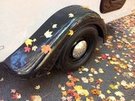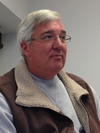 by bobhenry » Wed May 22, 2013 9:56 am
by bobhenry » Wed May 22, 2013 9:56 am
Here are some of the rough notes from my D.O. seminar I gave at the Crossroads gathering in 2011
I have to thank a couple of my fellow campers Jared and Misty Lucky for this info for I was unaware they existed …Basically a giant muffin cup~~~of Parchment or aluminum foil. These D.O. liners are available and make cleanup soooo much easier. They also make removal of baked goods go much smoother.
My big meatloaf secret……
DRIP COLLANDER FOR GREASE REMOVAL OF ROASTS, MEAT LOAF ETC.
3 BALLS OF ALUMINUM TO KEEP IT OFF THE BOTTOM
We will move to equipment needs and cost effective ways around these needs to save you some big bucks.
D.O. TABLE $150 - $250 MY WALKER 10.01
CHIMNEY $13.00 CAN IN A CAN 0.00
WELDING GLOVES $20.00 HEAVY CANVAS 66 CENTS
LIFTER $20.00 PLIERS FROM HOME 0.00
UTENSIL SET $30.00 GOODWILL 1.00 EACH
COAL SHOVEL $15.00 USE BIG SPOON ABOVE 0.00
LID HOLDER/ TRIVET 13.00 GAS STOVE GRATE 0.00
WINDSCREEN $10.00 4-5 LICENSE PLATES AND
Wooden storage box $19.00 KEY RINGS < 1.00
Nylon storage bag $15.00 38 –44 jeans 4.00
$ 271.00 - $371.00 $ 15.67
do you have an extra $300 - $400.00 to start cookin today how about $15-$20
Demonstrations cooking in the fire ring on coals not the fire
No skillet no problem ! cookin’ on the lid
No cook top no problem boiling / frying in the d.o.
No feet no problem gas stove grate
Tools:
gloves , lifter or pliers, shovel, tongs, starter chimney( mine + old can starter) , D.O. table ( mine. Satellite dish oil change pan and grill ) ,
NOTE : I need some white chalk to mark level in chimney
strainer, trivet, parchment paper D.O. ;liners paper and foil and scissors, a wind screen / grill , wisk broom, cooking thermometer
foil ( universal lid). scotchbrite pad ,wood utensils, butchers string
The single most important topic TEMPERATURE CONTROL this will be a good place to take a few notes.
Some folks ~~~Dia.X2 place evenly top and bottom some say to then move 2 up some say 3 up others yet say 4 up. I have found that THIS system works best for me and the math is fairly simple
Dutch oven temperature adjustment
To arrive at approximately 350 degrees in a 12 inch oven you would use 24 briquettes. Depending on the type of cooking you are doing, you may need to make the heat come more from the top or bottom of the oven. For example, too much heat on the bottom will burn bread.
To control the TYPE of cooking, you place more or less of the briquettes on the lid.
Here is a simple chart:
Baking 3/1 More heat from top so bottom does not burn.Place 3/4 coals on top and 1/4 underneath.
Roasting Heat comes equally from top and bottom.Place 1/2 coals on top and 1/2 underneath.
Stewing, Simmering 1/3 Most heat from bottom.Place 1/4 coals on top and 3/4 underneath.
Frying, Boiling All heat from bottom.Place all coals underneath.
A few others modes of cooking ; deep fry , broiler, slow cooker or use as a steamer
If you roast in the oven at home all the heat is the same, it’s the same with a dutch oven even coals top and bottom
If you fry at home all your heat from the burner is from the bottom,
It is the same with a dutch oven all the coals on the bottom.
This leaves 2 types of cooking left to remember. Baking and stewing/simmering. So for baking use 3 to 1 ratio your 12” takes 24 coals for 350 degrees so that is 18 on top 6 on the bottom .
Now flip this same math upside down for stewing/simmering. 1/3 or 6 on top and 18 on the bottom
A home oven as a standard burner while a large commercial oven has a larger oven and a bigger burner so a larger Dutch oven will also require a bigger burner.
Interactive ask the group
A 14” dutch oven uses ? coals for 350 degrees 28
To bake we need what ? 3 to 1 21/7
To roast we will need what? 1 to 1 14 / 14
To stew/simmer we will need what? 1 to 3 7 / 21
And to fry or boil ? 0 / all 28
350 degrees has cooked everything I have ever fixed. Cooking is simply time and temperature. Lower temperature = more time
A higher temperature = less time.
However, if you really want to know a single briquette adds about 12 – 15 degrees. So add one top and 1 bottom for 375 2 top and 2 bottom for 400 and so on. So to adjust up or down add or subtract pairs as you wish.
Rotating to avoid hot spots.
When you set your oven down have the lid facing you so you can read it or find someway to note the position. The lid position will remain unchanged throughout the entire cooking process, Rotating is a simple thing every 10 – 15 minutes turn the pot ¼ turn clockwise but return the lid to its original position.
You have effectively rotated the bottom heat ¼ turn clockwise and the top heat ¼ turn counterclockwise without any confusion.
Growing older but not up !






 Most new dos come pre seasoned. Many folks are of the camp that this is adequate. Others feel it is not and should be removed and reseasoned. I have done it both ways and dont see a big difference. As Doug often says, others mileage may vary. Sorry, i know you were looking for a definative answer, and I only muddied the water. I might suggest you visit the campcook website at the top of the page under "TD friendly websites". And poke around there for an anwser to your question from some real experts.
Most new dos come pre seasoned. Many folks are of the camp that this is adequate. Others feel it is not and should be removed and reseasoned. I have done it both ways and dont see a big difference. As Doug often says, others mileage may vary. Sorry, i know you were looking for a definative answer, and I only muddied the water. I might suggest you visit the campcook website at the top of the page under "TD friendly websites". And poke around there for an anwser to your question from some real experts.

 ) I decided on making
) I decided on making